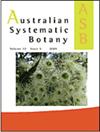天南星科飞毛莲不定根的解剖及其对该属分类学的重要性
IF 1.6
3区 生物学
Q4 EVOLUTIONARY BIOLOGY
引用次数: 0
摘要
摘要黄花菜属包括以下三个目前公认的亚属:黄花菜亚属;黄花菜,P. subg。翼龙属和翼龙属。Meconostigma;然而,它们缺乏定义良好的分类。在本研究中,我们检查了不定根的解剖学样本在该组的物种,以便建立有关方面的分类学目的。解剖分析强调了从接近顶端的区域到最成熟区域的根样本横截面上的石柱特征。为了澄清结果,研究中还包括了一种密切相关的阿德龙属,即A. crinipes。我们的研究结果表明,绿柱头亚属的种间存在显著差异,主要表现在叶状柱头的存在(及其变异)上,而柱状柱头在绿柱头亚属的共同特征中较为突出。黄花菜,P. subg。蕨类植物及其近缘种。此外,P. subg。黄花菜和黄花菜。Pteromischum证实了这两个分类群之间的亲缘关系比与P. subg亲缘关系更近的系统发育假说。Meconostigma。本文章由计算机程序翻译,如有差异,请以英文原文为准。
Anatomy of the adventitious roots of Philodendron (Araceae) and its importance for the systematics of the genus
Abstract. The genus Philodendron Schott comprises the following three currently accepted subgenenera: P. subg. Philodendron, P. subg. Pteromischum and P. subg. Meconostigma; however, these lack a well-defined classification. In the present study, we examined anatomically samples of adventitious roots in species of the group, so as to establish aspects relevant for taxonomic purposes. The anatomical analyses emphasised the characteristics of the steles in cross-sections of the root samples from regions near the apex to the most mature zones. A species of a closely related genus Adelonema, namely A. crinipes, was included in the study to clarify the results. Our results indicated notable differences in the species of the subgenus Meconostigma, mainly in terms of the presence (and variations) of a lobed stele, whereas the cylindrical stele stood out among the common characteristics in P. subg. Philodendron, P. subg. Pteromischum and the related species A. crinipes. Moreover, the characteristics shared by P. subg. Philodendron and P. subg. Pteromischum corroborated the phylogenetic hypothesis that these two taxa were more closely related to one another than to P. subg. Meconostigma.
求助全文
通过发布文献求助,成功后即可免费获取论文全文。
去求助
来源期刊

Australian Systematic Botany
生物-进化生物学
CiteScore
3.10
自引率
12.50%
发文量
12
审稿时长
>12 weeks
期刊介绍:
Australian Systematic Botany is an international journal devoted to the systematics, taxonomy, and related aspects of biogeography and evolution of all algae, fungi and plants, including fossils. Descriptive taxonomic papers should normally constitute a comprehensive treatment of a group. Short papers on individual species and nomenclatural papers must contain significant new information of broader interest to be considered. The prestigious L.A.S. Johnson Review Series is published. Other review articles will also be considered. All papers are peer reviewed.
Australian Systematic Botany is published with the endorsement of the Commonwealth Scientific and Industrial Research Organisation (CSIRO) and the Australian Academy of Science.
 求助内容:
求助内容: 应助结果提醒方式:
应助结果提醒方式:


